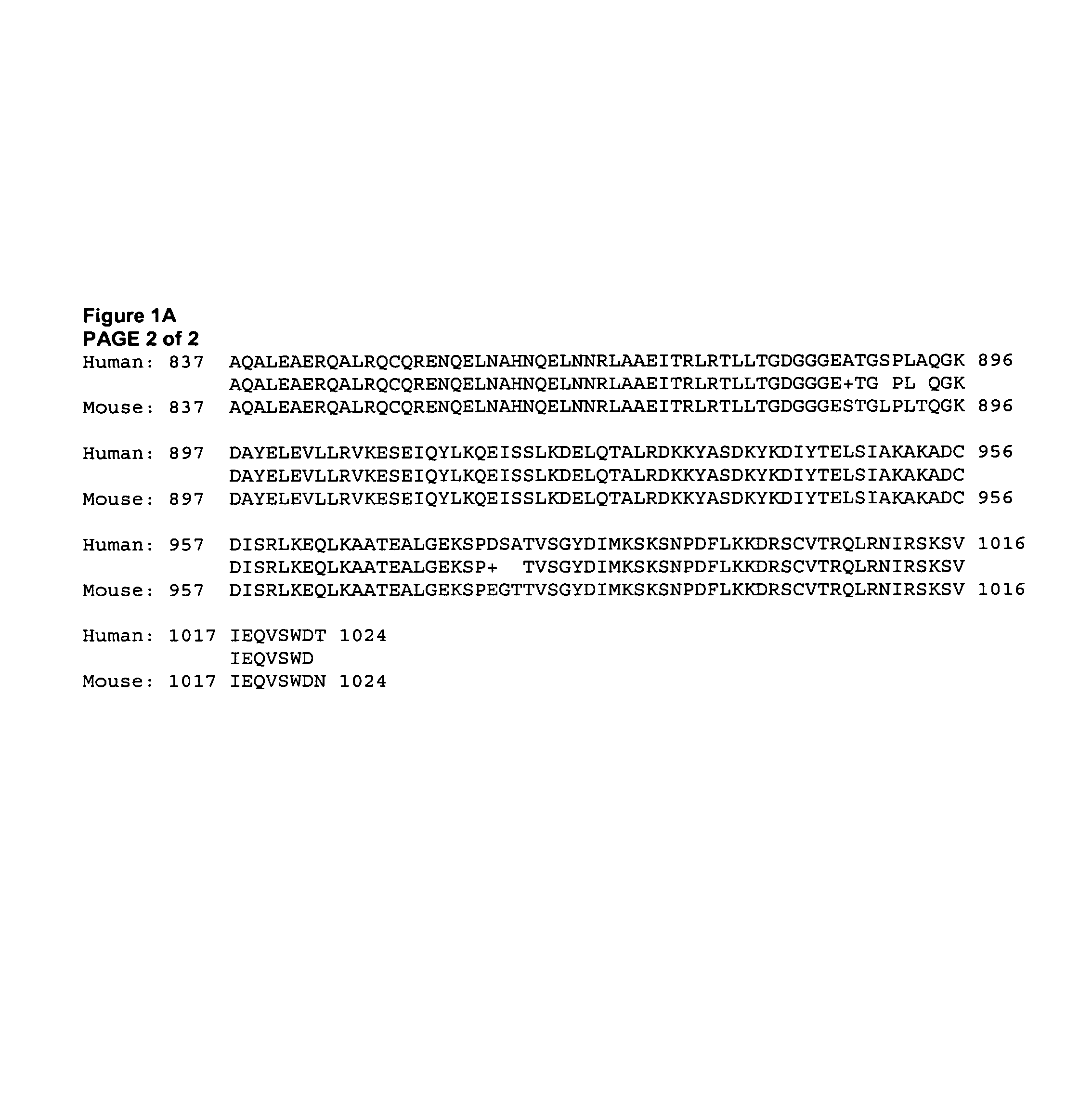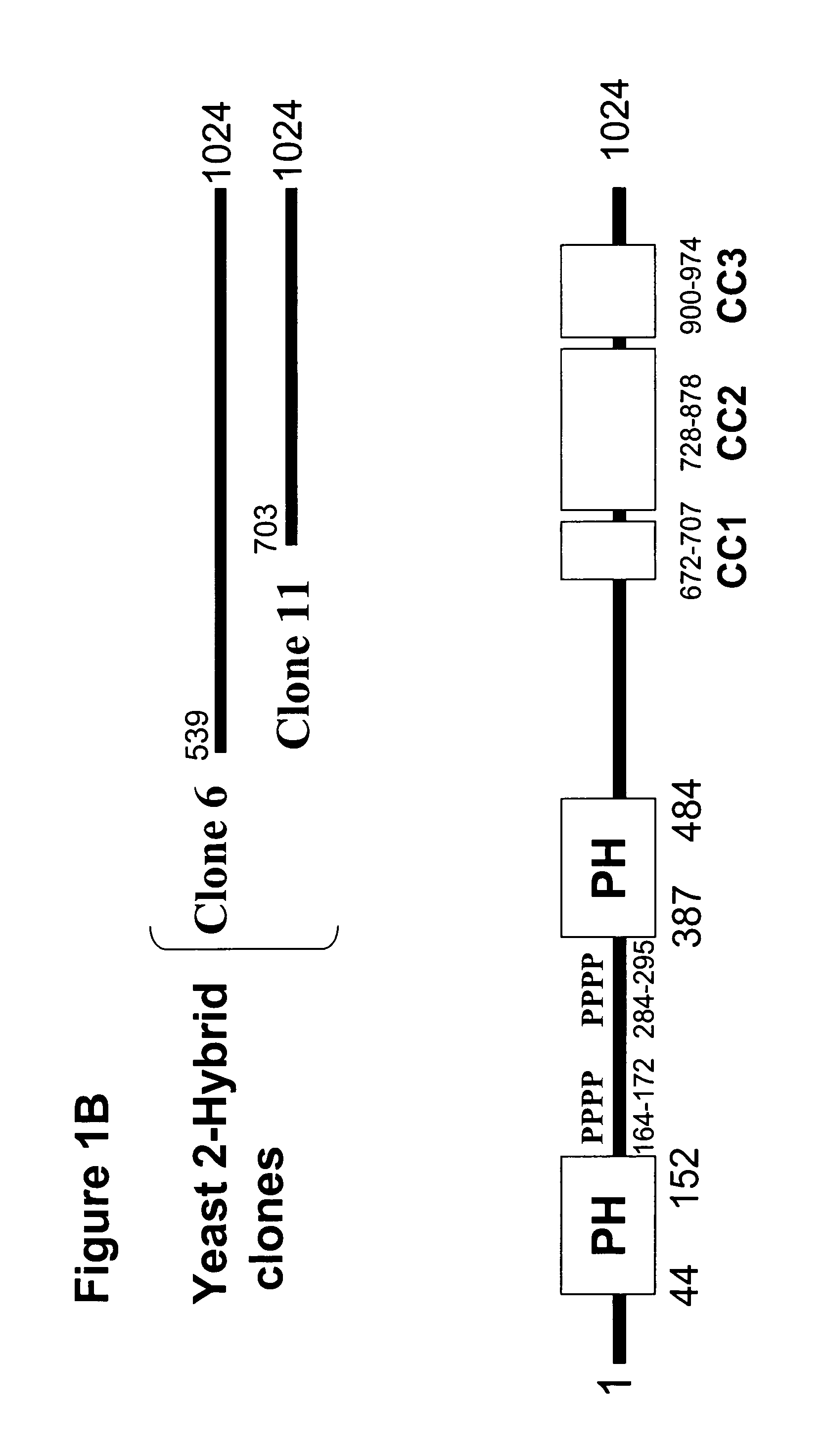Compositions involving M-RIP, and related methods for screening for anti-hypertensive agents, and uses thereof
- Summary
- Abstract
- Description
- Claims
- Application Information
AI Technical Summary
Benefits of technology
Problems solved by technology
Method used
Image
Examples
example 1
Identification and Cloning of M-RIP
[0106]To identify proteins involved in regulation of myosin phosphatase, base pairs 2043–3090 of human MBS (MBS-Cterm) were used as bait in a yeast 2-hybrid screen of a human aorta library. Two clones, 6 and 11, encoded the 3′ regions of a cDNA with high homology to a murine RhoA-interacting protein, p 116RIP3 (Gebbink et al., (1997) J. Cell Biol. 137:1603–1613). When retransformed into yeast, both clones interacted with MBS-Cterm but not with the Gal4 DNA binding domain alone. Clone 6 was homologous to base pairs 1617–3072 and clone 11 was homologous to base pairs 2109–3072 of murine p116RIP3.
[0107]A human aorta library was next probed for 5′ sequence of human p116RIP3. PCR using the human aorta library as a template yielded a 1,686 bp product that was highly homologous to the 5′ sequence of murine p116RIP3. The full length human clone was constructed by overlap extension PCR using the yeast 2-hybrid clone 6 and the 5′ 1,686 bp sequence (FIG. 1A)....
example 2
Detection and Localization of M-RIP in Vascular Smooth Muscle Cells
[0109]Specific MRIP antisera were raised and tested first by immunoblotting of lysates from COS7 cells transfected with full-length M-RIP cDNA. Anti-M-RIP recognized a specific band of 125 kD in untransfected COS7 cells that was augmented by overexpression of full-length MRIP (FIG. 2A). A parallel immunoblot of the same lysates in which anti-M-RIP was pre-absorbed with immunogen failed to identify any M-RIP band. Anti-M-RIP was next used to probe lysates from two different human arterial smooth muscle cell lines. Anti-M-RIP identified a specific 125 kD band in these lysates, supporting that M-RIP is expressed in human vascular smooth muscle cells (FIG. 2B). Although M-RIP from vascular smooth muscle cells was completely insoluble at 250 mM NaCl, it was solubilized and immunoprecipitated under high ionic strength conditions (FIG. 2C).
[0110]Cultured human coronary artery smooth muscle cells were immunostained with anti...
example 3
In Vivo Interaction Between M-RIP and Myosin Phosphatase
[0111]To explore whether the interaction between M-RIP and MBS detected in yeast occurs in intact vascular smooth muscle cells, immunoprecipitation experiments were performed with human aortic smooth muscle cell lysates. Immunoprecipitation of either M-RIP or MBS led to recovery of both proteins (FIG. 3A), supporting an in vivo interaction between M-RIP and MBS in vascular smooth muscle cells. Furthermore, M-RIP immunoprecipitation also led to recovery of PP1 and cGMP-dependent protein kinase (FIG. 3B,C), supporting the hypothesis that M-RIP is associated with the myosin phosphatase complex in vivo. In GST-pulldown interaction studies, binding between M-RIP and either PP1 or cGMP-dependent protein kinase could not be detected, indicating that M-RIP interacts with these proteins indirectly via their known interactions with MBS.
PUM
| Property | Measurement | Unit |
|---|---|---|
| Pressure | aaaaa | aaaaa |
| Nucleic acid sequence | aaaaa | aaaaa |
Abstract
Description
Claims
Application Information
 Login to View More
Login to View More - R&D
- Intellectual Property
- Life Sciences
- Materials
- Tech Scout
- Unparalleled Data Quality
- Higher Quality Content
- 60% Fewer Hallucinations
Browse by: Latest US Patents, China's latest patents, Technical Efficacy Thesaurus, Application Domain, Technology Topic, Popular Technical Reports.
© 2025 PatSnap. All rights reserved.Legal|Privacy policy|Modern Slavery Act Transparency Statement|Sitemap|About US| Contact US: help@patsnap.com



